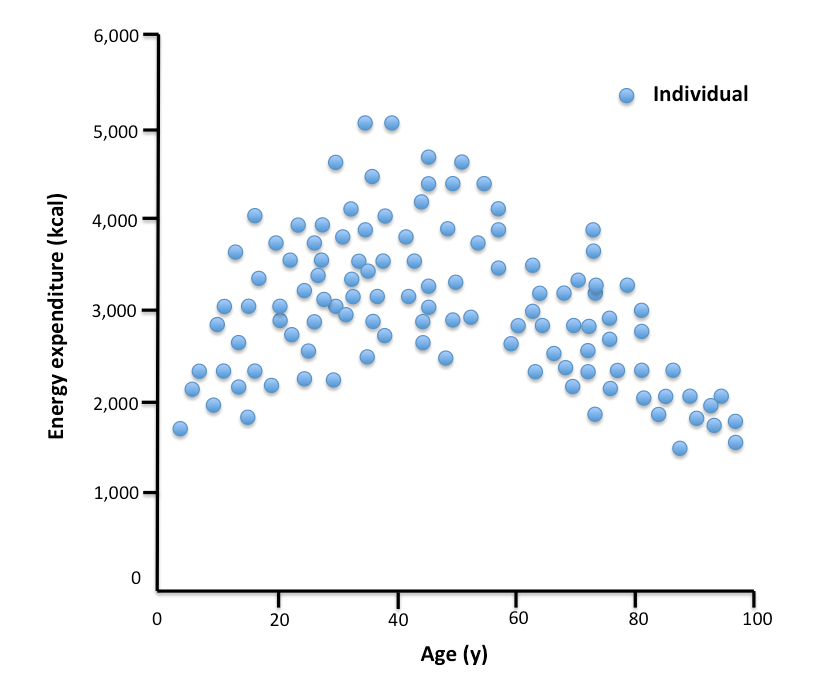What is the ideal calorie intake for my goals? How can I calculate calories I burned during exercise? These are two frequently asked questions. However, nobody can give a precise answer. Well, you could get a very good estimate if you spend 24 hours in a metabolic chamber to determine the energy expenditure. However, who has the access to such a facility?
The numbers used by professionals or in calorie calculators are rough estimates derived from scientific studies. It is important not to forget that scientists publish means. The numbers give the average of an entire subject group. Individuals can be subjected to large variations and their calorie requirements can be more than 500 kcal above or below average. The image below shows how a possible energy expenditure distribution among subjects of an examined group can look like.
Individual energy requirements are dependent on many factors, such as weight, age, gender, genetics and the activity level.1 Only some of these factors can be considered in a generalized equitation.
Age - Increasing age leads to decreased energy expenditure, not only during rest, but also during exercise and for body’s metabolic processes, such as food digestion.1
Gender – Women spend on average 16% less energy than men.1 However, some studies have shown that it's not the gender but the amount of the lean body mass that is responsible for the higher energy expenditure in men compared to women (men have relatively more of the more ‘energy consuming’ muscle mass than women).4,5
Genetics – Differences in body composition in the range of 25-50% can be attributed to genetics variability. Because more muscle mass requires more energy supply, it is likely that this leads to increased energy expenditure.1
Exercise - Physical activity contributes to a lesser extent to the total energy expenditure when compared to the basal energy expenditure. The basal energy expenditure is the energy that is needed to sustain metabolic activities, to maintain blood circulation, respiration and other essential processes in the human body.1
It is difficult to determine how much energy a person spends during exercise. Although heart rate monitoring can give an estimate how intense a training session is, it doesn’t take into account the individual training level and the body composition of the trainee. Advanced trainees, especially endurance athletes, become more efficient with energy utilization, not only because of body’s adaptations to the training intensity but also because of more effective technique.2
Additionally, more individual variability is created by our digestive systems. An important question is not only how many calories we consume, but how many calories we absorb and utilize. Here, the composition of the individual gut microbiota may play a significant role. For instance, the microbiome of obese individuals was suggested to have the ability to extract more energy from food.3
Bottom line
Biological systems, including humans, are chaotic and influenced by many unpredictable factors. We can’t put precise numbers on energy dependent processes in the human body. If you want to achieve a specific goal determine your starting point, meaning your current caloric intake, first. Increase or decrease it by 200-500 kcal/day, depending on your goal (weight gain or loss) and monitor how your body reacts. If you don't see the desired changes after 2-3 weeks, make further adjustments.
References
- http://www.nap.edu/openbook.php?isbn=0309085373
- T.R. Baechle, R.W. Earle, Essentials of strength training and conditioning, third edition
- Turnbaugh, P. J., Ley, R. E., Mahowald, M. a, Magrini, V., Mardis, E. R., & Gordon, J. I. (2006). An obesity-associated gut microbiome with increased capacity for energy harvest. Nature, 444(7122), 1027–31.
- Johnstone, A.M., Murison,S.D., Duncan, J.S., Rance,K.A. & Speakman, J.R. (2005). Factors influencing variation in basal metabolic rate include fat-free mass, fat mass, age, and circulating thyroxine but not sex, circulating leptin, or triiodothyronine. American Journal of Clinical Nutrition, 82, 941-948.
- Lazzer, S., Bedogni, G., Lafortuna, C.L., Marazzi, N., Busti, C., Galli, R. De Col, A., Agosti, F., & Sartorio, A. (2010), Relationship between basal metabolic rate, gender, age, and body composition in 8,780 white obese subjects. Obesity, 18(1), 71-78.

